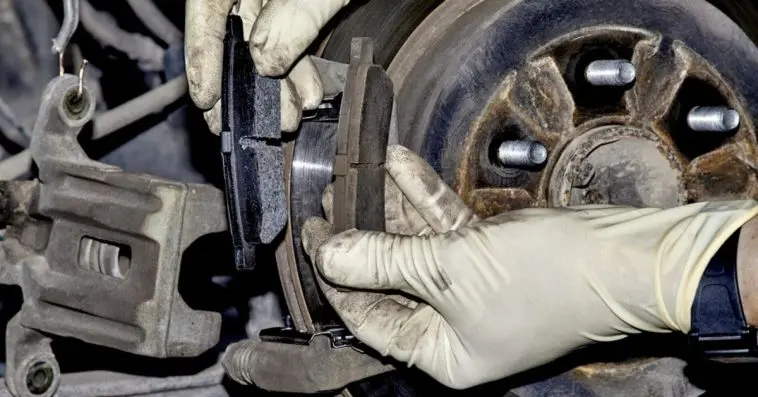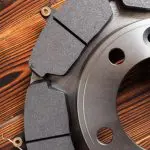The car braking system might just be the most sensitive and delicate part of the car as it helps in preventing accidents on a daily basis.
The components of the braking system are similarly delicate and should be examined every time you have a chance or when you take the car for a service appointment.
One of the parts of the braking system is the brake pads that will need to be changed every once in a while.
Do you know how to change your brake pads? You can decide to change your brake pads by yourself. If so, you will need to follow the following procedure:
- Raise Your Car Using A Good Jack, And Remove The Tire
- Disassemble The Disc Brake System
- Change The Brake Pads
- Change The Brake Caliper Assembly
- Place Back The Tires
Apart from the brake pads, you will also need to have a look at your brake rotors and if they are in poor condition, get new ones.
As a driver, you should be keen to notice any irregularities with your car braking system to avoid risking the lives of the passengers.
This can be seen in the manner that the car brakes respond whenever you step on the brake pedal.
TABLE OF CONTENTS
What Should You Need To Know Before Replacing Your Brake Pads?
The following are a couple of useful information that you should be aware of before you begin replacing your brake pads:
- The type of calipers in your car: Some cars have a fixed caliper while others have a sliding caliper. You should know the one in your car so that you have an easy time working with it.
- Work one side before proceeding to the other: It is important that you should change the brake pads on one side before proceeding to the other side.
The steering wheel should also be placed in a manner in which the wheel you are working with is angled out so you can access the brakes in a better position.
Also, I recommend you to check this article on how to check your brake pads.
Brake Pads Replacement Guide: 5 Steps You Should Take!
After assembling the tools and every other needed equipment, you can start the process of changing your brake pads.
This should be easy as long as you have the tools and you know where the brake pads are located.
Tools You Will Need:
- Mechanic gloves
- Jack and jack stands
- Wrench
- Plastic tie or bungee cord
- A turkey baster that will be needed for drawing brake fluid
- C-clamp
Materials You Will Need:
- The set of new brake pads
- Brake fluid
- Car Owner’s manual
1. Raise Your Car Using A Good Jack, And Remove The Tire
For this process, the tires must be removed, and this is just the same as when you are replacing a punctured car tire.
You will have to start with loosening the lug nuts from the wheel you want to change their brake pads.
The next step is to jack up the car and get this done the right way. Once done, complete with unscrewing the lug nuts from the tire and remove it from the car.
2. Disassemble The Disc Brake System
You will then see the disc brake system on the wheel axle. You will have to get a socket wrench to take off the bolts that are behind the caliper assembly.
The next step is to take off the caliper assembly from the rotor. You can then access the brake pads and remove them from the rotor while being careful not to damage the rotors in the process.
3. Change The Brake Pads
As the old brake pads have been removed, you can now replace them with the set of new ones.
This should be done by first applying the brake grease onto the back of the pads, as this will help reduce the squeaking noise when you apply brakes to your car.
The next step is to place the new brake pads at the same position the old once were removed from.
4. Change The Brake Caliper Assembly
The next cause of action is to replace the brake caliper assembly into position.
This will need a little bit of adjusting since the caliper assembly is designed to fit the position of the brake pads in use.
When the old ones wore out, the piston in the caliper assembly was forced to adjust to their smaller width.
Hence, for the new ones with broader width, you will need to fix them to fit well.
You can do this by placing one of the brake pads in the caliper assembly in a manner that it is positioned against the large circular piston.
You can then work the brake tool until the caliper assembly fits the new brake pads.
5. Place Back The Tires
As you will have completed the task, you should have a final check on the disc brake system and ensure that every component is placed as it was before.
If you are sure of this, then you can set the tire back onto the axle and remove the jack from beneath the car. Ensure the lug nuts are tightly screwed in position using the tire iron.
I found this helpful YouTuber’s video!
Frequently Asked Questions
Now you know how to install new brake pads with the instruction I gave above.
If you keep reading the information, you will find questions often asked by most readers who are mainly curious about the main subject!
Q1: How Long Does It Take To Change Brake Pads?
Changing brake pads will take a duration ranging from 30 minutes to an hour. This should be done with a mechanic who knows their way around the brake system.
This is because this is a rather technical task that requires someone well-versed in the field. Unlike changing a spare tire, it is a technical activity.
You will need to pull up to your nearest auto repair shop for this service and let an expert handle it.
They will get the task done and avoid damaging other car parts in the process.
In the end, you get to drive away with your car, which will have an excellent braking system, and hence no damage will be passed onto other parts like the brake rotors and calipers.
If you had delayed the changing of your brake pads, the whole process might have turned out to be quite costly.
Q2: How Often Should I Change My Brake Pads?
The number of times you have to replace your brake pads after driving around 50,00miles, and it also depends on several factors.
Most of these factors are centered on the degree of damage exerted on the brake pads when in use.
The following factors explain why the rate of changing brake pads varies from one car to another.
1. The Owner’s Driving Habits
You might notice that some drivers have the habit of applying sudden sharp brakes. They might also be into driving the car at high speeds.
This increases the rate of wearing out of the brake pads as it requires a lot of force for the car to brake in these instances.
Eventually, a lot of force is applied to the brake pads, and this causes their wearing out.
For those that drive at fairly low speeds and usually apply smooth and gradual braking, their brake pads will enjoy a longer lifespan.
2. Are In Which The Car Is Driven
For cars that are frequently driven in a less jammed up highway, the brakes are rarely used. This is unlike a situation where a car is used in a city with heavy traffic.
For the city cars, a lot of braking is applied as the car moves on the road as the driver will want to move and stop while the traffic progresses.
Cars that are also driven down steep roads will also use the brake often as the driver will want to control the downhill speed. As such, the brake pads will wear out faster.
3. The Brand Of The Brake Pads
How often you will need to replace your brake pads also depends on the brand of the brake pads.
Some are designed to persevere through harsh conditions and are thus suitable for cases where the brakes are used more often.
Other factors that will determine how often the brake pads are to be changed include the weight of the load on the car as well as the material used in the manufacture of the brake pads.
You will find that ceramic brake pads are quite long-lasting as well as steel brake pads.
If you also carry a heavy load on your car like on a daily basis, then the weight will eat up your brake pads more than in a situation where a car has less weight.
Q3: Can I Just Replace Brake Pads And Not Rotors?
No, brake rotors will also need to be replaced at some point in their lifetime. This is because they might get warped, gouged are simply wear out.
Having them working in a car might be dangerous for any car owner as the braking ability will be reduced.
If you can’t afford to replace your brake rotors, you can have them resurfaced when you take your car for a brake pads replacement.
The brake caliper, brake pads, and the rotors form what is referred to as the car disc brake system.
The rotors, as well as the brake pads, are bound to wear out at some point in their lifetime and will need replacement.
The brake rotors are mainly affected with the friction applied during the braking of the car.
For instance, when brakes are applied all of a sudden, excessive heat is caused, and this leads to the warping of the rotors. Too much aggressive braking also wears out the rotors.
The rotors will also be damaged if you ignore and delay to replace the brake pads.
Therefore, if you replace your brake pads early enough, you will not have to get new brake rotors installed in your car as they will be protected from damage by the brake pads in good working condition.
Q4: Can I Put New Brake Pads On Old Rotors?
Yes, you can install new brake pads on set of old brake rotors.
This is because the old rotors may not be in poor condition after all and will be protected from wearing out with the new set of brake pads.
You just need to ensure that the brake rotors are not in such a severe case. You will also not be forced to resurface the old rotors.
Even as a thin layer of the brake pads is transferred to the brake rotors, and may create optimal friction for the car to stop, this should not be an issue when you are getting new brake pads installed.
When you install new brake pads, the “contaminated” surface of the rotor has little effect on the safety of the car.
It is common for some car owners to get new rotors installed every time they have to replace the brake pads.
This should not always be the case as the brake rotors have a longer lifespan than the brake pads.
It is also true that the brake pads protect the brake rotors, and hence you will not be forced to replace them frequently.
Q5: Is It Safe To Drive With Bad Rotors?
You should, in fact, not drive in a car with bad rotors.
This might be putting you and other passengers at risk of being involved in an accident as the braking would not be as effective as you wish it to be.
Hence, you are at high risk of colliding with obstacles as well as other motorists on the road because of your poor braking system.
For one, the car might experience temporal brake failure that arises from the complications with the brake fluid.
This will then cause poor transmission of hydraulic pressure that is needed for the braking of the car. This alone is enough cause of alarm to any car owner.
A braking rotor in poor condition may put you at risk when you are driving in a poor weather condition.
For instance, when it is snowing, such a vehicle will not be able to brake effectively due to the warping of the rotors.
Rotors in bad condition tend to transfer the damage to the car Anti-Lock Braking System.
This will turn out to be rather costly, unlike if you had just replaced your brake rotors when you were supposed to.
Conclusion
Maintenance of a car’s brake system is essential to reduce the chances of the car getting involved in an accident.
This is because every car owner needs their car braking system to be in good condition for a much better response when they step on the brake pedal to avoid a collision.
The main components in the car braking system that gets worn out first before the others are the brake pads.
They are what distribute friction over the surface of the metallic parts, the rotors, and the calipers, which bring the car tires to a halt.
Even though some brands of brake pads are designed to be long-lasting, eventually, they get worn out, and you will need to replace them.
Replacing them will not take more than an hour, and the time, effort, and resources you will put in this process will be worth it.
Sources:
1. Lifehacker – https://lifehacker.com/how-to-change-your-cars-brake-pads-1783117085
2. The Family Handyman – https://www.familyhandyman.com/project/how-to-change-front-brake-pads/




